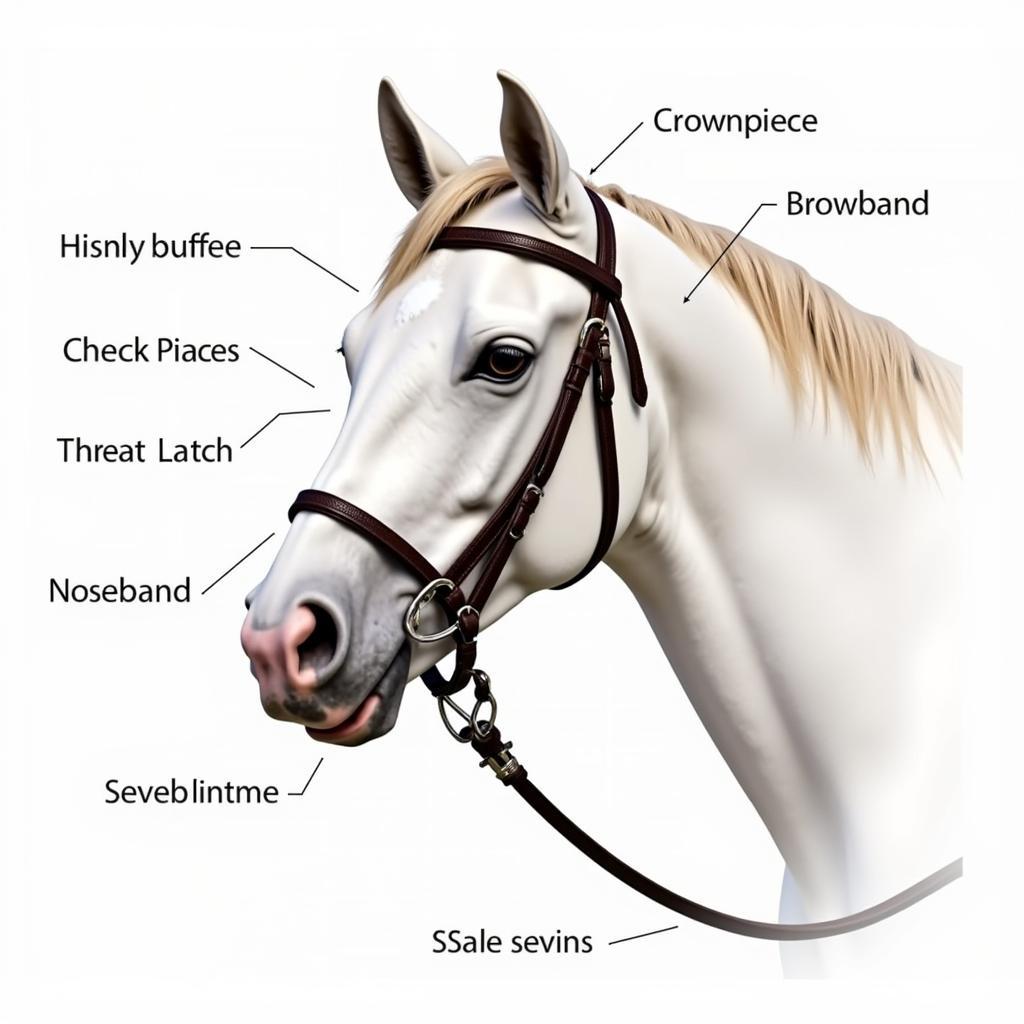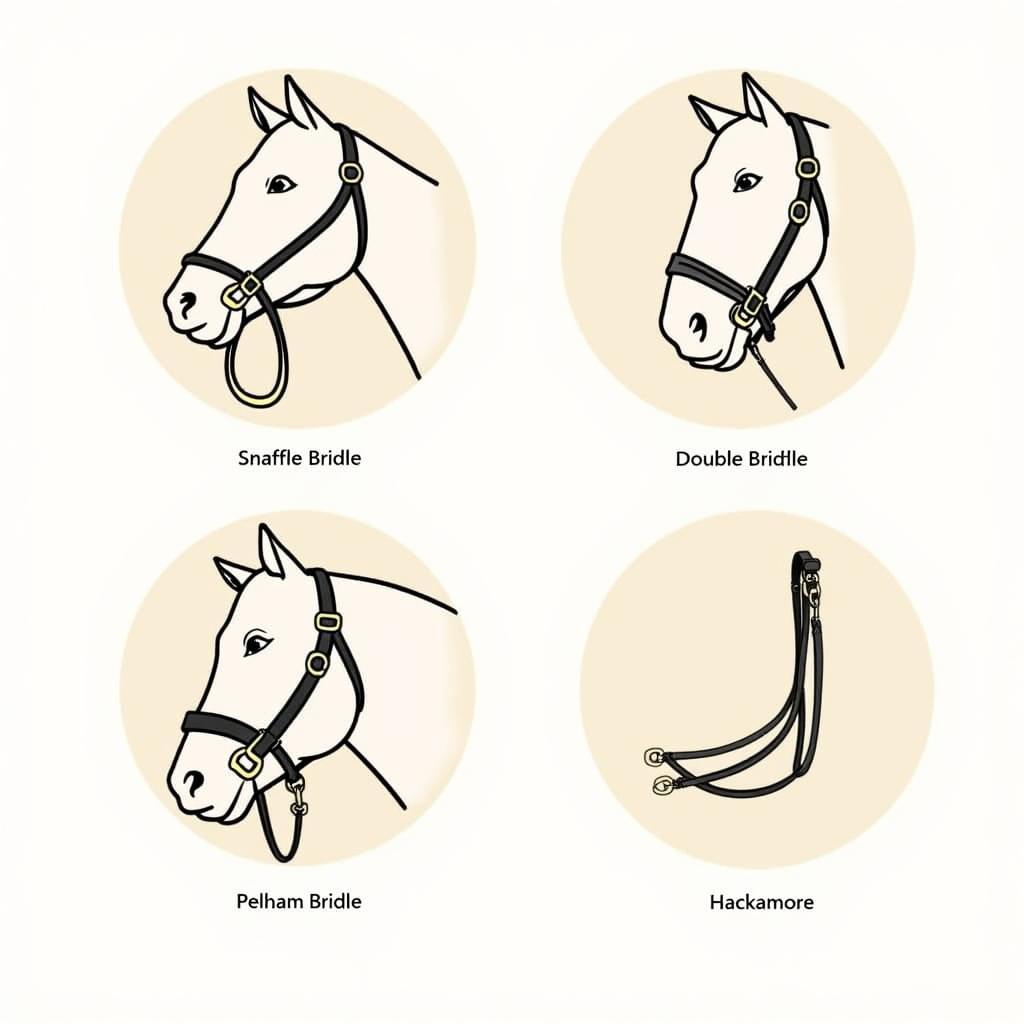A Bridle For A Horse is an essential piece of equipment for any equestrian. It provides a way for the rider to communicate with the horse and control its movements. Choosing the right bridle is crucial for both horse and rider comfort and safety.
 Horse Bridle Parts
Horse Bridle Parts
Understanding the Purpose of a Horse Bridle
Before delving into the intricacies of different bridle types, let’s understand the fundamental purpose of this equipment. A bridle primarily serves two key functions:
- Control and Communication: Through the bit, which sits in the horse’s mouth, and the reins connected to it, the rider can signal directions, adjust speed, and manage the horse’s posture.
- Head and Face Support: The bridle’s structure, including the crownpiece, browband, and cheek pieces, helps to distribute pressure evenly around the horse’s head, ensuring a comfortable fit and preventing the bit from being pulled through the mouth.
Types of Horse Bridles
The world of equestrian gear offers a vast array of horse bridles, each designed for specific disciplines or purposes. Let’s explore some of the most common types:
1. Snaffle Bridle
This is the most basic and widely used type of bridle, commonly used for riding and training young or inexperienced horses.
- Features: A snaffle bridle features a single bit with a direct rein action, meaning the rider’s hand movement directly translates to pressure on the bit.
- Ideal For: General riding, flatwork, jumping, and training young horses.
2. Double Bridle
The double bridle, as the name suggests, incorporates two bits: a bradoon (a thinner bit similar to a snaffle) and a curb bit (a thicker bit with shanks and a curb chain).
- Features: This bridle provides more leverage and control, making it suitable for advanced riding disciplines.
- Ideal For: Dressage, high-level show jumping, and other disciplines requiring refined communication and control.
3. Pelham Bridle
The Pelham bridle offers a middle ground between the snaffle and the double bridle.
- Features: It uses a single bit with two sets of reins, one attached directly to the bit rings like a snaffle and the other to the shanks, creating a curb action.
- Ideal For: Riders who want more control than a snaffle offers but are not ready for the complexity of a double bridle.
4. Hackamore
Unlike the previous types, a hackamore doesn’t utilize a bit in the horse’s mouth.
- Features: It relies on leverage applied to the nose, chin, and poll (the area behind the ears) to control the horse.
- Ideal For: Horses with mouth sensitivities or injuries that make using a bit uncomfortable or detrimental.
 Types of Horse Bridles
Types of Horse Bridles
Choosing the Right Bridle for Your Horse
Selecting the right bridle for your horse is crucial for their well-being and performance. Consider these factors:
- Horse’s Age and Experience: Start young or green horses with a simple snaffle bridle and gradually introduce more complex bridles as their training progresses.
- Riding Discipline: Choose a bridle that aligns with the specific requirements and traditions of your chosen equestrian discipline.
- Horse’s Conformation and Sensitivity: Consider your horse’s individual anatomy and any sensitivities they might have. For instance, a horse with a fleshy tongue might require a different bit type or mouthpiece.
- Fit and Comfort: Ensure the bridle fits your horse properly and comfortably. Ill-fitting bridles can cause discomfort, pain, and even injury.
Caring for Your Horse Bridle
Proper care and maintenance will extend the life of your bridle and ensure its safety and effectiveness.
- Regular Cleaning: Clean your bridle regularly with saddle soap and water to remove dirt, sweat, and grime.
- Conditioning: Use leather conditioner to keep the leather supple and prevent drying or cracking.
- Inspection: Regularly check all parts of the bridle for any signs of wear and tear, including stitching, buckles, and the bit.
FAQs about Horse Bridles
1. How do I know if my horse’s bridle fits correctly?
A well-fitting bridle should lie flat against the horse’s head without any gaps or pinching. The browband should sit comfortably below the horse’s ears, and the cheek pieces should allow for two fingers to fit comfortably between the cheek and the bridle.
2. How often should I clean my horse’s bridle?
Ideally, you should clean your horse’s bridle after every ride. However, if you ride frequently, cleaning it a few times a week is acceptable.
3. Can I use the same bridle for different horses?
It’s best to have a dedicated bridle for each horse to ensure proper fit and hygiene.
4. What are some signs of a poorly fitting bridle?
Signs of a poorly fitting bridle include rubbing or sores on the horse’s face, head tossing, resistance to the bit, and excessive salivation.
5. How long do horse bridles typically last?
The lifespan of a horse bridle depends on the quality of materials, frequency of use, and care. With proper maintenance, a good-quality bridle can last for several years.
Need More Help?
Choosing and fitting a bridle for a horse is a crucial aspect of equestrianism. If you’re unsure about any aspect of selecting or caring for your horse’s bridle, don’t hesitate to reach out for expert advice. Contact us at Phone Number: 0772127271, Email: [email protected], or visit us at QGM2+WX2, Vị Trung, Vị Thuỷ, Hậu Giang, Việt Nam. We have a dedicated customer support team available 24/7 to assist you.